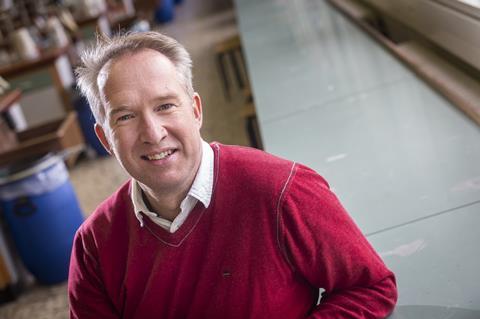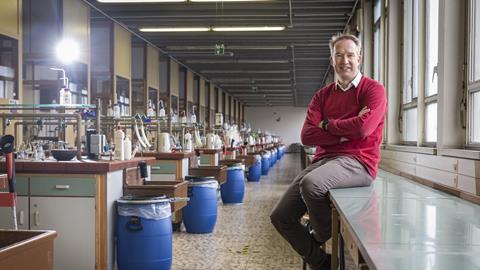If Filip Du Prez has his way, thermosets such as epoxies will be almost as recyclable as thermoplastics in a few years’ time. The first step is to gain a better understanding of how cross-linked plastics work at the molecular level. ’We want to spend the next four years building up knowledge about the combinations of parameters that lead to the best possible material.’
Could you cross-link small molecules into a polymer as precisely as nature does with amino acids? And could such ‘precision polymers’ serve as models for more recyclable materials? In 2021, Ghent professor Filip Du Prez received an ERC Advanced Grant to devote five years to this topic. Thanks to precision polymers, he hopes to learn more about the link between the exact structure of polymer chains and their physical and chemical behaviour. The ultimate goal is to develop industrial thermosets, such as epoxy resins and polyurethanes, that are still useful after use.
’In hot areas, wind turbine blades must retain their thermal stability’
This is certainly not the case with the current generation of thermosets, whose production now stands at 65 million tonnes a year, according to Du Prez. It doesn’t get much better than grinding them for use as fillers. Unlike thermoplastics, they do not soften, let alone melt, when heated. Science doesn’t really have an answer to this yet. It’s only now, as the first generation of wind turbines needs to be replaced, that people are starting to realise that they can’t get to grips with the growing pile of discarded fibreglass-reinforced epoxy blades. ‘Every month I receive a query from a company that wants to know more about the applications of reusable resins or wants to collaborate in this area’, says Du Prez.
How did you come up with this topic?
’It stems from our earlier research on self-healing plastics. At that time, the approach was different: how can you make a certain end product last longer before you throw it away? Our own technology, with capsules containing a liquid that fills cracks, ultimately proved unable to meet the desired material specifications. Others have managed to commercialise something, but it is still limited to niche markets. For example, the BMW iX has a self-healing grille, and you can buy a self-healing screen protector for your iPhone. But the triggers that start a self-healing process, such as a rise in temperature or UV light, can also be used to make the material deformable, so you can start recycling it. So you could use some of the same chemical platforms to do that.

The obvious solution would be to break the cross-links that bind the molecules of the chain together to form a rigid network. But this reasoning turns out to be too simple.
’You have cross-links that open completely above a certain temperature, say 120 degrees. But then you go very quickly from something that is solid to something that becomes too liquid. So we often work with special forms of what are called dynamically covalent networks. If you break cross-links in these networks, you are left with reactive ends. These can react with each other again a little further down the line. So the total number of crosslinks remains constant, but they move to different places. This allows you to deform the material without it becoming completely liquid.
‘The total number of cross-links remains constant, but they move to other places’
To recycle it, you can, for example, grind it and then make new shapes out of it in a conventional extruder or injection moulding machine, just as you do with thermoplastics. But you can also, for example, make a complex car part out of a flat sheet of composite material. You can even imagine parts that fit together and, when heated locally, stick together to form one large molecule. A last-generation wind turbine blade is about a hundred metres long and almost impossible to transport by road. They have to be cut into large pieces that can be assembled on site.’
It is reminiscent of the vitrimers once introduced by the Frenchman Ludwik Leibler.
’Yes, I knew him well and we quickly started working together in this field. But the polyester chemistry he was originally using required such large quantities of metal catalysts that scaling up made little sense. That got me thinking. I saw much greater potential, including industrial potential, and I have been doing a lot of research with him and other colleagues ever since. In this respect, it is good that organic and polymer chemistry are in the same building at UGent. I myself am a polymer chemist. Without the years of collaboration with people working on small molecules, such as my colleague Johan Winne, I would definitely not be where I am today.
Won’t dynamically covalent materials be very expensive?
‘Absolutely not. We have already shown that you can start with cheap commercial building blocks that are already used in the chemical industry. For example, typical epoxy resins made up of epoxy and amine components. In our case, it is enough to replace a small part of these amines with other cross-linkers, with dynamic binding between the amino groups.’

And doesn’t recyclability come at the expense of other technical characteristics that have been tinkered with for decades?
‘We can show that it does not. If you only have to add a small percentage of a chemical to make it recyclable, you hardly see any effect. Of course, you have to make sure that the dynamic properties only start at a certain temperature. To give a concrete example, even in a desert area where it is much warmer than here, your wind turbine blades should maintain their thermal stability.’
How do the precision polymers from your ERC grant fit into this picture?
’Specifically, these are sequence-defined polymers. This means that all the chains are the same length, unlike conventional plastics, which tend to vary widely in length. Not only do you know exactly what their mass is, but you can also very specifically incorporate certain functional groups or catalysts. We use these to see if we can further optimise the material properties.
‘The big challenge is reading the information present on these precision polymers’
Until recently, it was barely possible to synthesise half a gram of such uniform polymers. They were often used in a biomedical context, where milligrams are actually sufficient. The challenge has been to scale this up. We can now make tens of grams of polymers that have never been used in thermosets before. From these, we can synthesise whole sets and see how different parameters affect the properties.
You previously compared it to peptide synthesis.
’The synthesis method is actually very similar. Protein synthesis in the lab has been done for decades with Merrifield resins, functionalised beads on which amino acids click. Nowadays, there are robots that can do this kind of work. We have modified one of these robots so that it can work with typical chemical building blocks such as acrylates and amines. And instead of these beads, we have now also developed a soluble support material that we can easily remove afterwards. This allows us to synthesise the quantities needed for materials research.
‘There are so many factors out of my control’
With such completely uniform polymers, you get a network structure that is much more homogeneous than the current generation. We do not intend to scale this up industrially: the final industrial materials do not need to be that precise. But we want to spend the next four years building up knowledge about the combinations of parameters that lead to the best possible material. We just don’t have the full understanding yet.
You have previously published on the use of such sequence-defined polymers to store data, as an alternative to DNA.
‘This is still a hot topic in my group. It is very different from thermosets. The big scientific challenge is not scaling up, because you need very few of them, but being able to read out the information on such precision polymers. At the moment we mainly use mass spectrometry to reconstruct the chains, but we are working on non-destructive alternatives. After several brainstorming sessions, we realised that combining these two areas of expertise could lead to knowledge that nobody else has the opportunity to build. So that was what came up in the application for the ERC grant.’
You were recently featured in the magazine Trends as a scientist who is able to do something for the economy. How long will it take for one of your ideas to become an industrial reality?
“I’m convinced that the first of my own materials could be on the market in about five years, but it’s always very dangerous to say that. As a scientist, I know where we are now, but there are so many factors out of my control. The companies we are working with now also have to decide to go full steam ahead. This is a challenge I have faced many times in my career. Just when everything is ready, there is another war or crisis and you have to postpone. So what is it going to be in reality?













Nog geen opmerkingen